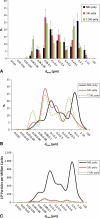The John Charnley Award: an accurate and sensitive method to separate, display, and characterize wear debris: part 1: polyethylene particles
- PMID: 21997780
- PMCID: PMC3254734
- DOI: 10.1007/s11999-011-2057-x
The John Charnley Award: an accurate and sensitive method to separate, display, and characterize wear debris: part 1: polyethylene particles
Abstract
Background: Numerous studies indicate highly crosslinked polyethylenes reduce the wear debris volume generated by hip arthroplasty acetabular liners. This, in turns, requires new methods to isolate and characterize them.
Questions/purposes: We describe a method for extracting polyethylene wear particles from bovine serum typically used in wear tests and for characterizing their size, distribution, and morphology.
Methods: Serum proteins were completely digested using an optimized enzymatic digestion method that prevented the loss of the smallest particles and minimized their clumping. Density-gradient ultracentrifugation was designed to remove contaminants and recover the particles without filtration, depositing them directly onto a silicon wafer. This provided uniform distribution of the particles and high contrast against the background, facilitating accurate, automated, morphometric image analysis. The accuracy and precision of the new protocol were assessed by recovering and characterizing particles from wear tests of three types of polyethylene acetabular cups (no crosslinking and 5 Mrads and 7.5 Mrads of gamma irradiation crosslinking).
Results: The new method demonstrated important differences in the particle size distributions and morphologic parameters among the three types of polyethylene that could not be detected using prior isolation methods.
Conclusion: The new protocol overcomes a number of limitations, such as loss of nanometer-sized particles and artifactual clumping, among others.
Clinical relevance: The analysis of polyethylene wear particles produced in joint simulator wear tests of prosthetic joints is a key tool to identify the wear mechanisms that produce the particles and predict and evaluate their effects on periprosthetic tissues.
Figures







References
-
- Affatato S, Bersaglia G, Emiliani D, Foltran I, Taddei P, Reggiani M, Ferrieri P, Toni A. The performance of gamma- and EtO-sterilised UHMWPE acetabular cups tested under severe simulator conditions. Part 2. Wear particle characteristics with isolation protocols. Biomaterials. 2003;24:4045–4055. doi: 10.1016/S0142-9612(03)00264-3. - DOI - PubMed
MeSH terms
Substances
LinkOut - more resources
Full Text Sources

